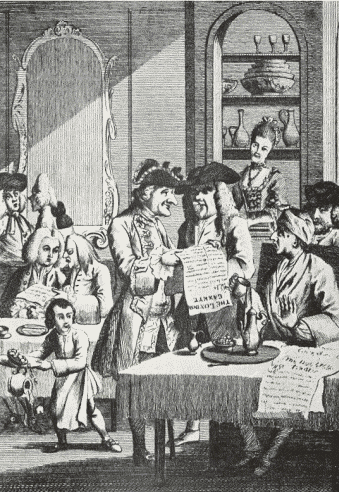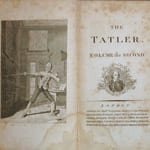To read a newspaper was to read
in part the work of fellow readers
~The Longman Anthology of British
Literature
 |
| The London Gazette |
The Newspaper of 18th century England contained different informative contents than today’s newspapers. In the beginning, the “newspaper” took the form of a news-book, pamphlet or just a piece of paper with notes. During its circulation, periodicals made “the transition from a small pamphlet containing some definite piece of news…to the sheet published periodically under a distinctive and regularly repeated name” (“The Growth of Journalism”). The news-books were smaller than the papers seen today, but they were similar in that they were also distributed weekly to the public and as stated in “The Growth of Journalism,” the news-book/pamphlet did not have the same formal news style as that of the full newspaper. It was only after 1665 and the production of the Oxford Gazette when the newspaper “was a folio half sheet, printed on both side in double columns” (Sutherland vii). No matter what the size, with the growth of these papers came the growth of a new type of literature for people to read. From the newspaper also surfaced the production of periodicals, which portrayed more the identity of the author/editor of the paper. It was in the 18th century that “the inventors of the periodical essay extended the tactic of the fictitious self into new territory” (Damrosch 2462), providing for the reader insight into the author’s feelings toward public issues.“The periodical press…gave its readers a new way of seeing the world, and of seeing themselves in the world, as private beings and public entities” (Damro
 |
| Newspapers in the Coffeehouse |
sch 2453).
Interest in papers increased as newspaper articles covered topics such as politics, the lives of public individuals, and business. Furthermore, with the growth of papers came the increase of readership as newspapers went from being just a limited conversation among friends, to appearing in London coffeehouses, to being distributed everywhere as they are today. However along with the popularity came the government’s desire to control what would and wouldn’t appear in articles. The government attempted to monitor the paper as they were “issued by, or in behalf of, groups of politicians, or news purveyors” (The Growth of Journalism). “Monarchs and politicians tried hard to control the press, to dictate its views and to contain its criticisms, but in Britain the phenomenon proved too large for such arrant limitation (Damrosch 2453), as some well-know writers, such as “Swift, Addison, and Steele” wrote and contributed their own material to newspapers (“The Growth of Journalism”). In addition to newspapers, periodicals also became another avenue for author’s to express themselves.
Readership
For readers newspapers detailed the news and notes of current events and the works of famous literary authors. Gossip and interest grew as readers were able to get together and discuss the contents of the newspaper where ever they were distributed. “The press not only stimulated but also simulated conversation (Damrosch). In coffeehouses, interaction among the public was created by the periodical and its articles and the atmosphere contained a “sociability which is part of the periodical’s means of production, its consumption and its subject matter” (Iona 77). With the distribution of papers everywhere from coffeehouses to businesses, a wide range of individuals were able to read these periodicals. “Since periodicals were frequently lent out, shared, read aloud or consulted in a public place, a single copy may have been read by many people” (Iona 9). Newspapers were similar to novels in the sense that they were for everyone to read as either a hobby or to make conversation with friends. The articles presented a different world for the reader to be a part of whether following politics or the local news. In addition, as with many early novels, newspapers traded on the assumption that they were reporting what “actually” happened, though they often blurred the boundaries between fact and fiction.
Licensing
With newspapers growing in size and number, the restored monarchy made every attempt to control the paper’s appearance and the content it contained. The government created “licenser’s of the press,” in Sir John Berkenhead and Roger L’Estrange for example, who would “hunt down heretical and seditious publications” (Sutherland 1). Another way the government attempted to monitor the paper was with the introduction of the Licensing acts. During the Restoration period the restored monarchy “tried through strict licensing laws to limit the flow and narrow the range of newsprint, but whenever those laws lapsed, innovations [in the newspaper] abounded” (Damrosch 2453).The Licensing Act of 1662 pertained to periodicals and public writings and how they had to contain the author’s and publisher’s name and had to be given to a licenser before publication. The control of printing was in the hands of the government and all papers had to be licensed in order to be produced for the public (Licensing Act). In response to these laws authors worked to publish papers which showcased how they thought their periodicals should look, which led to the different forms of the paper. The content switched from that which was focused on the political to that which contained the writings of novelists and the individualities of newspaper editors such as Richard Steele’s The Spectator.
 |
| The Tatler |
Timeline
1665- The London (Oxford) Gazette, government published paper
1702- The Daily Courant, the first English daily newspaper
1709- The Tatler, weekly published periodical
1711- The Spectator newspaper is published
1713- The first journals to be published weekly
1731- The Gentleman’s Magazine, was similar to that of the newspaper but was composed more of works created from authors of the time period
For more information: Eighteenth Century Journalists and Periodicals
Return to The Restoration and the 18th Century homepage
Works Cited
Damrosch, David, and Kevin J.H. Dettmar. The Longman Anthology of British Literature. 3rd ed. United States: Pearson Education, Inc., 2006.
Iona Italia, The Rise of Literary Journalism in the Eighteenth Century. New York, NY:Routledge, 2005.
“Licensing Act.” The Literary Encyclopedia. 2 Apr. 2004. Accessed 12 Apr. 2008.
http://www.litencyc.com/php/stopics.php?rec=true&UID=1407<span
London Gazette Image from: https://sites.udel.edu/britlitwiki/files//2018/06/428px-London-gazette.gif
Newspaper in the Coffeehouse image found through Creative Commons, from:
http://www.south-central-media.co.uk/tuppenny_press.htm
Sutherland, James. The Restoration Newspaper and its Development. Great Britain: Cambridge University Press, 1986.
“The Growth of Journalism.” Bartleby.com 7 May 2008 http://www.bartleby.com/224/0401.html</span>
The Tatler image found through Creative Commons, from: http://www.library.otago.ac.nz/exhibitions/18thc/cabinet11/</span>
Contributor:
Lindsay Milbourne
